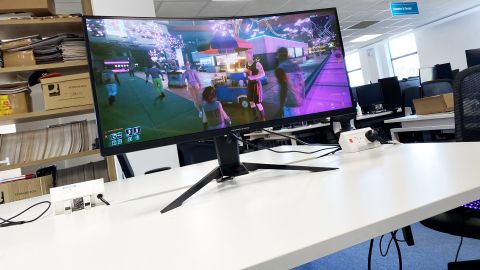Does less than $400 buy you a premium gaming panel? That kind of money barely touches the sides when it comes to graphics cards these days. But the new ASRock Phantom PG34WQ15R2B gives you a 34-inch ultrawide experience, with 165Hz refresh, 1ms response and even HDR support, all for just under $370.
What more do you really need? The catch, of course, it that mere specifications rarely tell the whole story with gaming monitors. We've seen several $2,000 screens with outrageous on-paper capabilities recently that thoroughly disappointed. What are the odds that ASRock has delivered at well under $400?
Beyond those headline figures, the PG34WQ15R2B certainly looks promising. Predictably, it's based on VA rather than IPS panel tech given the appealing pricing. That typically means compromising on pixel response performance, but not necessarily by a huge amount.
ASRock claims 1ms response by the MPRT metric. It doesn't provide a number for the more demanding grey-to-grey measure, but it's likely in the 2ms to 4ms region depending on just how aggressive ASRock's overdrive is.

Screen size: 34-inch
Resolution: 3,440 x 1,440
Brightness: 550 nits
Response time: 1ms MPRT
Refresh rate: 165Hz
Viewing angle: 178° H&V
Contrast ratio: 3,000:1 (panel native)
Features: VA panel, 91% DCI-P3, adaptive sync, 1x DisplayPort 1.4, 2x HDMI 2.0, DisplayHDR 400
Price: $369 | £419
Brightness is rated at a punch 550 nits, which is impressive at this price point, and you get DisplayHDR 400 certification, which is entry level stuff but better than nothing. Given the punchy backlight and the fact that the VA panel offers 3,000:1 native contrast, it actually all bodes pretty well for a half decent entry-level HDR experience.
The claimed 91% coverage of the DCI-P3 digital cinema space likewise isn't too shabby at this price point. As for connectivity, you're looking at a single DisplayPort 1.4 input, plus a pair of HDMI 2.0. You'll need to use the DP 1.4 interface to get the full 165Hz refresh, the HDMI ports are limited to 100Hz.
There's no USB-C connectivity, unsurprisingly, and not even a USB-A hub for hooking up peripherals. Oddly, however, ASRock has fitted this monitor out with an integrated high gain Wi-Fi antenna, which could help with reducing clutter and might just improve your networking performance, though that is an element we didn't test.

That you can have all that for $370 really is fantastic.
Rounding things out are AMD FreeSync Premium support, relatively gentle 1500R panel curve and a proper stand with height, tilt and swivel adjustment. It's quite the overall package for the money.
In theory, at least, but what about in practice? Initial impressions are reasonable. In default SDR mode, this isn't the punchiest panel, especially given the 550 nit brightness rating. But the calibration is reasonable, with only slightly oversaturated colors and just a little compression visible in darker tones. It's a pretty nice looking thing from a static image quality perspective.
But surprising things happen when you enable HDR in Windows. Tweak the SDR brightness settings in the Windows applet and the result is actually a more vibrant and pleasing SDR experience. Even better, the color balance is that little bit more natural and the slight compression in darker tones disappears.

Put simply, SDR content looks fab when running this panel in HDR mode. That's a very rare thing and it means you can and should run the PG34WQ15R2B in HDR mode all the time. Most monitors force you to toggle back and forth between SDR and HDR modes depending on content type. But not here. Hooray.
As for the HDR experience, it's about as good as you can reasonably expect from a DisplayHDR 400 panel with no local dimming. Running a game like Cyberpunk 2077 does actually look punchier and more dynamic in HDR mode, which is far from universally the case for this class of monitor. OK, it's not a true high dynamic range experience. But it's better than the vast majority of low-end HDR screens.
What about response? ASRock claims 1ms MPRT, but VA panel tech generally lags behind the best IPS panels. Unfortunately, the ASRock's fast MPRT mode crushes brightness so badly, it's hard to imagine anyone actually using it.

ASRock does also offer switchable pixel overdrive, albeit simply on and off rather than the multiple levels you usually see. With overdrive enabled, there is just a whiff of visible overshoot and inverse ghosting. But it is only the slightest whiff and the overall response is reasonably snappy.
As good as the best 1ms GtG IPS screens? Not quite, but at this price point, the response is good enough. The same goes for the 165Hz refresh and overall input latency. If extreme esports are your thing, you'll be better off with a higher refresh 1080p panel. But For everyone else, the PG34WQ15R2B is going to be quick enough, it really is.
Oh, and the ASRock's OSD menu is to be commended, too. It's simple, easy to navigate and isn't stuffed with pointless image presets that look like trash and nobody in their right mind would ever use.
So, yeah, this really is a surprisingly nice screen for the money. 34-inch ultrawide remains a really nice form factor for immersive gaming, you get a nice, contrasty VA panel, plenty of backlight punch provided you run the screen in HDR mode (in which setting SDR content in any case looks better), reasonable pixel response and high enough refresh for most gamer's purposes.
That you can have all that for $370 really is fantastic. That this is ASRock's first stab at a gaming screen is even more impressive.

